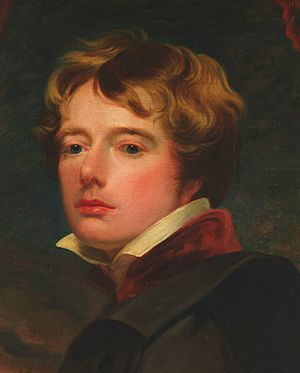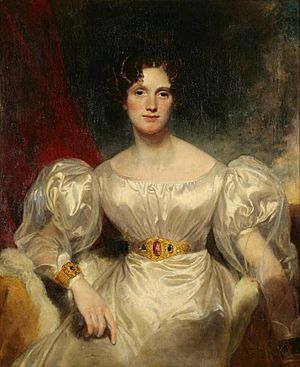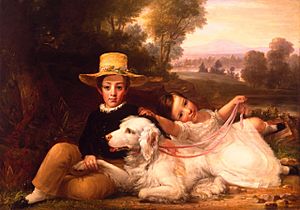George Henry Harlow facts for kids
George Henry Harlow (born 10 June 1787 – died 4 February 1819) was an English artist. He was best known for painting portraits of people.
Contents
Early Life and Training
Harlow was born in London, England. His father, a merchant, died before George was born. George grew up with his mother and five older sisters.
When he was young, Harlow went to different schools. He showed a strong interest in painting. First, he studied with Henry De Cort, a landscape painter. Then, he worked with Samuel Drummond, who painted portraits. After about a year, Harlow joined the studio of Sir Thomas Lawrence. Lawrence was a very famous portrait painter at the time.
Harlow paid Lawrence to join his studio. He was allowed to copy Lawrence's paintings. He also helped with parts of Lawrence's own artworks. Harlow spent about 18 months there.
Becoming an Artist
Harlow decided he wanted to be a painter. He turned down a job offer in the East India trade. This job was offered by his father's friends.
Harlow and Sir Thomas Lawrence later had a disagreement. Harlow even painted a funny sign for an inn. It was in Lawrence's style and had Lawrence's initials. This made it hard for them to become friends again.
After this, Harlow developed his own way of learning art. He didn't always agree with the rules of art academies. He was young and confident. He was also popular with people. Harlow liked to wear fancy clothes. Sometimes, his strong opinions annoyed people. His friends even gave him a nickname, "Clarissa Harlowe", after a book character.
Harlow worked very hard and was enthusiastic about his art. He could observe things quickly and remember them well. Once, he painted a good portrait of a man he had only met briefly. Even though he disagreed with the Royal Academy, he wanted to become a member. However, only one person, Henry Fuseli, voted for him.
Famous Paintings
Harlow first showed his art at the Royal Academy in 1804. It was a portrait of Dr. Thornton. Over the years, he showed many other portraits. He became very busy painting people. His portraits were well-designed. They looked a bit like Lawrence's work but had their own style. His paintings of women were especially graceful.
Harlow also wanted to paint historical scenes. But he was less successful at this. This was because his art training wasn't complete. His first historical paintings were Queen Elizabeth striking the Earl of Essex (1807) and The Earl of Bolingbroke entering London (1808).
In 1814, Harlow painted a series of portraits of the actor Charles Mathews. Mathews was shown in different characters. These paintings became very popular.
Harlow had made sketches of actors in the theatre when he was younger. One famous actress he drew was Sarah Siddons. She retired in 1812. Later, Harlow used these drawings to create paintings. One showed Siddons in a sleepwalking scene from Shakespeare's Macbeth. Another showed her in the letter scene from the same play.
A music teacher named Thomas Welsh asked Harlow to paint Siddons. She was to be shown as Queen Katharine from Shakespeare's Henry VIII. Harlow started this painting from memory. Later, Siddons agreed to pose for him.
While painting, Harlow decided to make the picture bigger. He turned it into the "Trial Scene" from the play. He added portraits of other actors, including members of the Kemble family. Mr. Welsh was very understanding about this change. The large painting was shown in 1817. It became very famous. The portrait of Mrs. Siddons as the queen is still considered a striking work of English art.
Later Years and Legacy
In 1818, Harlow felt he needed to improve his skills. He traveled to Italy to study the old master painters. In Rome, he was welcomed by many artists. The famous sculptor Canova was especially impressed by him. Canova even helped Harlow meet the Pope.
Harlow worked very hard in Italy. He copied Raphael's famous painting Transfiguration in just 18 days. He was chosen as a member of the Academy of St. Luke in Rome. This was a rare honor for an English artist. He was also asked to paint a self-portrait for the Uffizi gallery in Florence. He painted a picture called Wolsey receiving the Cardinal's Hat in Westminster Abbey. He gave this painting to the Academy in Rome.
Harlow made great artistic progress in Italy. But when he returned to England in January 1819, he became very ill with a throat infection. He died on 4 February, at only 31 years old. He was buried in St. James's Church, Piccadilly. Many important artists attended his funeral.
An exhibition of his main works was held in Pall Mall. Harlow's works show what a talented artist he was. Many of his portraits were later made into engravings. His self-portrait for the Florence gallery was also engraved. He even included his own portrait in the background of The Trial of Queen Katharine.
Images for kids
-
Self-portrait of Harlow, Metropolitan Museum of Art











